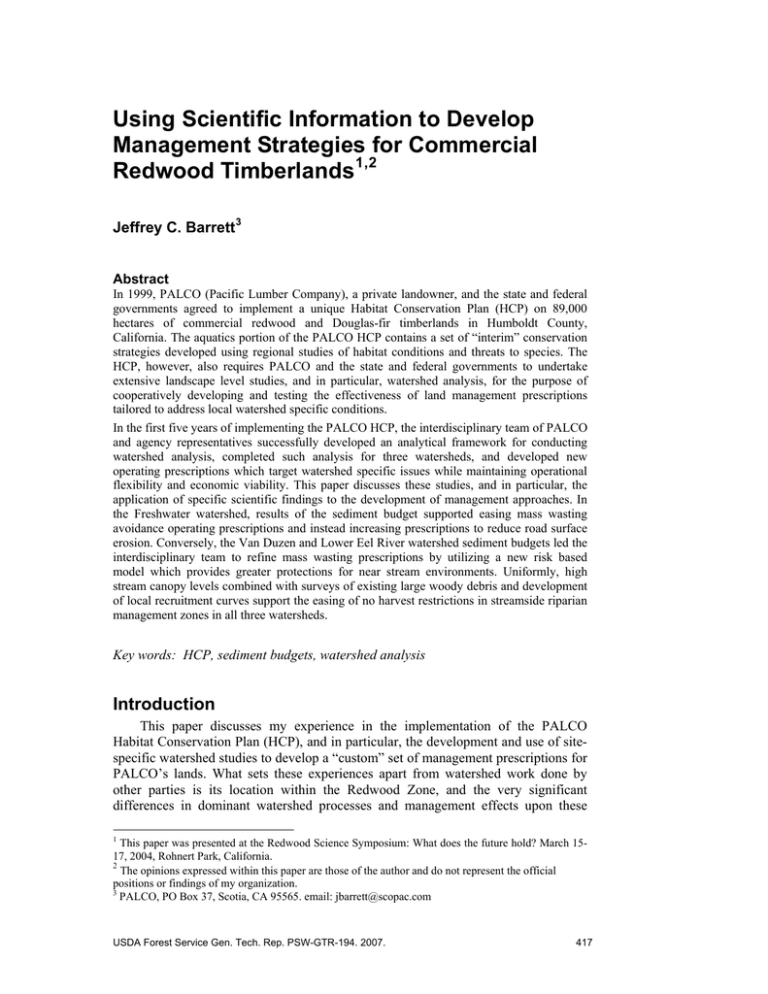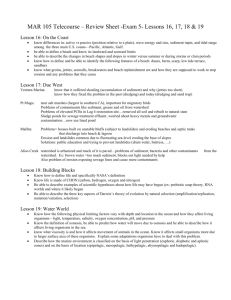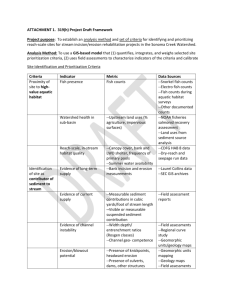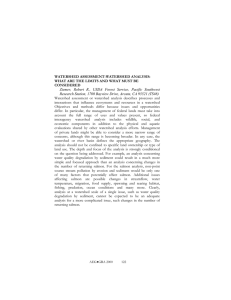Using Scientific Information to Develop Management Strategies for Commercial Redwood Timberlands
advertisement

Using Scientific Information to Develop Management Strategies for Commercial Redwood Timberlands 1,2 Jeffrey C. Barrett 3 Abstract In 1999, PALCO (Pacific Lumber Company), a private landowner, and the state and federal governments agreed to implement a unique Habitat Conservation Plan (HCP) on 89,000 hectares of commercial redwood and Douglas-fir timberlands in Humboldt County, California. The aquatics portion of the PALCO HCP contains a set of “interim” conservation strategies developed using regional studies of habitat conditions and threats to species. The HCP, however, also requires PALCO and the state and federal governments to undertake extensive landscape level studies, and in particular, watershed analysis, for the purpose of cooperatively developing and testing the effectiveness of land management prescriptions tailored to address local watershed specific conditions. In the first five years of implementing the PALCO HCP, the interdisciplinary team of PALCO and agency representatives successfully developed an analytical framework for conducting watershed analysis, completed such analysis for three watersheds, and developed new operating prescriptions which target watershed specific issues while maintaining operational flexibility and economic viability. This paper discusses these studies, and in particular, the application of specific scientific findings to the development of management approaches. In the Freshwater watershed, results of the sediment budget supported easing mass wasting avoidance operating prescriptions and instead increasing prescriptions to reduce road surface erosion. Conversely, the Van Duzen and Lower Eel River watershed sediment budgets led the interdisciplinary team to refine mass wasting prescriptions by utilizing a new risk based model which provides greater protections for near stream environments. Uniformly, high stream canopy levels combined with surveys of existing large woody debris and development of local recruitment curves support the easing of no harvest restrictions in streamside riparian management zones in all three watersheds. Key words: HCP, sediment budgets, watershed analysis Introduction This paper discusses my experience in the implementation of the PALCO Habitat Conservation Plan (HCP), and in particular, the development and use of sitespecific watershed studies to develop a “custom” set of management prescriptions for PALCO’s lands. What sets these experiences apart from watershed work done by other parties is its location within the Redwood Zone, and the very significant differences in dominant watershed processes and management effects upon these 1 This paper was presented at the Redwood Science Symposium: What does the future hold? March 1517, 2004, Rohnert Park, California. 2 The opinions expressed within this paper are those of the author and do not represent the official positions or findings of my organization. 3 PALCO, PO Box 37, Scotia, CA 95565. email: jbarrett@scopac.com USDA Forest Service Gen. Tech. Rep. PSW-GTR-194. 2007. 417 Session 9—Developing Management Strategies for Commercial Redwood Timberlands—Barrett processes on relatively small scales. In addition, I discuss some observations on how to successfully implement site-specific watershed studies within the context of protecting listed aquatic species. Study Area PALCO owns approximately 89,000 hectares of coastal redwood (Sequoia sempervirens) and Douglas-fir (Pseudotsuga menziesii) forests in northwestern California (approximately 165 km south of the Oregon border). Company lands are zoned for commercial timber production as their primary use. Although various research and monitoring studies are being conducted across the ownership, this paper focuses on efforts in three basins: Freshwater Creek, the Van Duzen River, and the Lower Eel River (fig. 1). Figure 1—Map of PALCO’s ownership the Freshwater, Van Duzen, and Lower Eel watersheds. 418 USDA Forest Service Gen. Tech. Rep. PSW-GTR-194.2007. Session 9—Developing Management Strategies for Commercial Redwood Timberlands—Barrett The Freshwater Creek watershed is an 81 km2 drainage basin located approximately eight km east of Eureka, California in Humboldt County. Approximately 77 percent of the watershed is owned and managed for timber by PALCO. Small, private residences and several ranches comprise most of the remainder of the lands in the basin. The Van Duzen River watershed area is a 185 km2 portion of the lower Van Duzen River basin located approximately 25 km southeast of Eureka. PALCO owns the majority of the lands within the study area. Other commercial timberlands, state and county parks, ranches, cattle and dairy, and rural development parcels make up the remainder of the study area. The Lower Eel watershed area is a 179 km2 portion of the lower Eel River basin, located approximately 35 km south of Eureka. PALCO owns over 80 percent of the lands within the study area, which is composed almost entirely of commercial timberlands. The geology in all three basins is dominated by marine sediments of relatively recent origin that have been uplifted through tectonic activity, with uplift rates on the order of 6.1 to 10.2 mm per year (Carver and Burke 1992). These high tectonic uplift rates have resulted in relatively extensive folding, faulting, and associated seismic activity. Freshwater has a relatively lower uplift rate, and is dominated by a rolling typography with more limited incised topographic features, and a relatively lower incidence of mass failure processes. By contrast, the Van Duzen and Lower Eel areas experience a higher tectonic uplift rate resulting in much steeper topography, deeply incised features, and a higher prevalence of mass wasting processes. The relatively recent origin of these marine sediments results in geologies that are weak, highly erodible, and susceptible to mass failure. Soils derived from these parent geologies are characteristically deep (>3 m) and are dominated by silts, clays, and other fine-grained materials. Methods A PALCO/agency team modified the watershed analysis methods developed by Washington DNR (WADNR 1994) to make them more applicable to PALCO’s lands (PALCO 2000). The work presented here focuses on findings relative to sediment budgets and riparian condition. All such work was done at a level equaling or exceeding so-called “Level II” studies within the DNR methodology. Sediment budgets were developed utilizing field-based measurements and computer modeling of hillslope and road mass wasting, road and harvest unit surface erosion, and streamside and bank-related landsliding. The sediment budgets developed estimates for both background and/or natural levels of sediment input and management-related sources. Assessment of riparian function focused on levels of canopy closure that provide shade and the potential for streamside forests to provide large woody debris to streams. Canopy levels were estimated from aerial photographs and were ground truthed. The potential for large wood recruitment was assessed based on the size and density of conifer trees along streams. Criteria for development of site-specific management prescriptions from the USDA Forest Service Gen. Tech. Rep. PSW-GTR-194. 2007. 419 Session 9—Developing Management Strategies for Commercial Redwood Timberlands—Barrett watershed analyses included the requirement for habitat to maintain, or achieve over time, a matrix of “properly functioning conditions” (PFCs) contained in PALCO's HCP (PALCO 1999). Analyses important to the prescription development phase include: 1) estimated historic sediment delivery as a function of distance from streams, slope, and stream type (in other words, fish bearing, non-fish bearing, ephemeral); and 2) large woody debris source distance curves using empirically derived field data. Results Watershed Specific Sediment Budgets In Freshwater, road-related erosion constituted more than 80 percent of all management-related sediment inputs (fig. 2). Of this, by far the most important was road-related surface erosion. This finding reflects the high density of roads in this basin (>2.5 km/km2), the erodibility of the soils underlying many of the road prisms, and the low incidence of mass wasting as a sediment source. Overall, annual inputs of management-related sediment were a little more than double the estimate of natural sediment inputs (161 metric tons/km 2 versus 68 metric tons/km2). Deep Seated Landslides Streamside Landslides Background Shallow Landslides Soil Creep Streamside Landslides Road Landslides/Gullies Management Road Surface Erosion Shallow Landslides Harvest Surface Erosion 0 50 100 150 200 250 300 350 400 450 Metric Tons/km^2 Figure 2—Annual sediment budget for the Freshwater Watershed Analysis Area. In contrast, the Van Duzen River management-related sediment sources were less than half as much as the natural sediment inputs (441 metric tons/km2/year versus 1,058 metric tons/km2year). Streamside landslides were, by far, the largest management-related sediment source (fig. 3), most resulting from historic tractor logging in steep, near stream areas. Although management sources were small compared to natural sediment, the total annual input of management sediment was 2.7 times greater than that observed in Freshwater. 420 USDA Forest Service Gen. Tech. Rep. PSW-GTR-194.2007. Session 9—Developing Management Strategies for Commercial Redwood Timberlands—Barrett Deep Seated Landslides Streamside Landslides Background Shallow Landslides Soil Creep Streamside Landslides Road Landslides/Gullies Management Road Surface Erosion Shallow Landslides Harvest Surface Erosion 0 50 100 150 200 250 300 350 400 450 Metric Tons/km^2 Figure 3—Annual sediment budget for the Van Duzen Watershed Analysis Area. For the Lower Eel, management-related sediment inputs again dominated the sediment budget (928 metric tons/km2/year versus 394 metric tons/km2year). All types of management-related sediment were significant sources, except harvestrelated surface erosion (fig. 4). In common with the Van Duzen, streamside landslides were the single greatest management-related sediment source. Lower Eel had, by far, the greatest management-related sediment yield, at 2.1 times the yield in the Van Duzen and 5.8 times the yield in Freshwater. Deep Seated Landslides Streamside Landslides Background Shallow Landslides Soil Creep Streamside Landslides Road Landslides/Gullies Management Road Surface Erosion Shallow Landslides Harvest Surface Erosion 0 50 100 150 200 250 300 350 400 450 Metric Tons/km^2 Figure 4—Annual sediment budget for the Lower Eel Watershed Analysis Area. USDA Forest Service Gen. Tech. Rep. PSW-GTR-194. 2007. 421 Session 9—Developing Management Strategies for Commercial Redwood Timberlands—Barrett Riparian Condition All three watershed analyses found that streamside canopy levels were high regardless of management history, vegetation type, or vegetation age. Canopy levels exceeding the 85 percent PFC level were present along 90, 77 and 72 percent of stream segments in the Freshwater, Van Duzen, and Lower Eel areas, respectively. Source recruitment curves for large woody debris delivery in the watersheds were similar. In all cases the majority of wood delivery to streams occurred from within 50 feet of the stream’s edge (fig. 5). In some cases wood delivery from greater distances was noted, particularly in steep incised features where landslides originating at some distance from streams were capable of delivering wood to the channels. However, such areas were relatively rare, and the effectiveness of any delivery mechanism (for example, landslides, wind throw, bank erosion, and so forth) decreased dramatically with distance. Cumulative Percentage of Recruited LWD 100 90 All Sources Windthrow 80 70 60 50 0 5 10 15 20 25 30 35 40 Distance From Bankful Channel Edge (m) Figure 5—LWD recruitment curve for the Freshwater Watershed Analysis Area. Development of Management Prescriptions As noted, PALCO’s HCP contains a series of interim conservation measures. Prescription writing used the sediment budgets and large woody debris recruitment relationships to determine whether the interim mass wasting and riparian prescriptions could be modified. For mass wasting, a two-part question guided prescription writing: 1) is mass wasting related sediment an important sediment source; 2) what specific combination of features (slope, distance from streams, stream type, and geomorphic indicators) were associated with that sediment delivery? Ultimately, a three-tiered, empirically derived, risk based approach was developed: Tier 1 = no harvest in the areas with the highest historic mass wasting sediment delivery rates, Tier 2 = required geologic review by a licensed geologist prior to harvest, with a mandatory “floor” that retains 50 percent canopy closure, and Tier 3 = required geologic review by a licensed geologist, but with no mandatory retention standard. For Freshwater, hillslope related mass wasting was a relatively unimportant sediment source, and so the less restrictive Tier 3 strategy was instituted watershed wide. For road-related mass wasting, continuation of the requirement that roads must be stormproofed to remove at-risk culverts, fill slopes, and so forth, was retained along with requirements to upgrade surfacing and road drainage for all roads used for specific harvesting operations. 422 USDA Forest Service Gen. Tech. Rep. PSW-GTR-194.2007. Session 9—Developing Management Strategies for Commercial Redwood Timberlands—Barrett For the Van Duzen, sub-basin specific sediment budgets identified three subbasins (Cummings, Root, and Hely creeks) with relatively higher road and hillslope failures. For these three sub-basins all three tiers of the mass wasting strategy were instituted with the locations and slope triggers of the individual tiers being dictated by the location and relative level of sediment delivery (table 1). On the ground, this strategy was much more site-specific and stream oriented than the bulbous, and qualitative science-based polygons typically delineated by the interim mass wasting strategy of PALCO’s HCP (fig. 6). Table 1—Percent of total mass wasting related sediment delivery to streams that occurred as a function of stream type, slope, and distance from streams in the Van Duzen Watershed Analysis area. Van Duzen Watershed Mass Wasting Sediment Delivery Stream type Percent slope Distance from stream Percentage1 Class I & II Class I & II Class I & II Class III >40 >40 >40 >60 0 - 30 m 30 - 61 m 61 - 91 m 0 - 30 m 12.2/75 23.5/15 3.3/0 8.3/0 1987-1997 1 First number is percentage sediment from hillslope landslides, second number is estimate for streamside landslides. For the Lower Eel watershed, sub-basin specific sediment budgets demonstrated that management-related mass wasting was significant in all areas, but that the location of at-risk areas differed among sub-basins. Ultimately we modeled sediment delivery to three sub-basins in detail (Bear, Jordan, and Stitz creeks) and then used the results to develop separate mass wasting strategies for different portions of the Lower Eel analysis area. As an example, for the Jordan Creek sub-basin, we again instituted all three tiers with the selection of tier level based on the magnitude of sediment delivery (table 2). Table 2—Percent of total mass wasting related sediment delivery to streams that occurred as a function of stream type, slope, and distance from a representative sub-basin (Jordan Creek) in the Lower Eel Watershed Analysis area. Lower Eel-Jordan Creek Watershed Mass Wasting Sediment Delivery Stream type Percent Distance from stream Percentage1 slope 1988-2000 Class I & II >50 0 - 30 m 6.7/70 Class I & II >50 30 - 61 m 2.3/5 Class I & II >50 61 - 91 m 2.7/5 Class III >50 0 - 30 m 3.1/0 1 First number is percentage sediment from hillslope landslides, second number is estimate for streamside landslides. USDA Forest Service Gen. Tech. Rep. PSW-GTR-194. 2007. 423 Session 9—Developing Management Strategies for Commercial Redwood Timberlands—Barrett Figure 6—Areas of restricted harvest under the interim (left) and post watershed analysis mass wasting avoidance strategies. 424 USDA Forest Service Gen. Tech. Rep. PSW-GTR-194.2007. Session 9—Developing Management Strategies for Commercial Redwood Timberlands—Barrett In contrast to management strategies to control mass wasting, which are often site specific, we have found that prescriptions for riparian areas on PALCO’s lands can be very similar. Watershed analysis and trend monitoring data demonstrate that high canopy closure conditions dominate virtually all channels, and that all the source-recruitment curves were comparable to that depicted in figure 5. The combination of high canopy levels and the near absence of wood recruitment from distances greater than 30m from streams led to significant reductions in the required buffer widths along streams: (table 3). These general guidelines were supplemented by site specific prescriptions for locations in need of additional corrective or protective prescriptions. For example, required buffer widths were increased along low gradient (< 4 percent) higher order Class I streams in the Van Duzen due to currently low large wood levels, and the importance of these areas for salmonid spawning. Table 3a Percent Slope No Cut buffer width (meters, slope distance) Outer band Selective Entry Band (meters, slope distance) Total Equipment Exclusion Zone Width (meters, slope distance) Interim Riparian Restrictions Class I Class II Class III <50 >50 <50 >50 <50 >50 0 - 30 0 - 30 0-9 0-9 3 3 30 -52 30 - 52 9 - 40 9 - 40 3-9 3-9 52 52-122 52 52 - 122 15 30 Table 3b—Riparian Management Strategies following watershed analysis. Class I 20-50 Revised Riparian Restrictions Class II >50 <20 20-50 >50 Percent Slope <20 No Cut buffer width (meters, 0 - 15 0 - 15 0 - 15 slope distance) Outer band Selective Entry Band (meters, slope distance) 15 - 23 15 - 30 15 - 38 Total Equipment Exclusion Zone Width (meters, 23 30 38 slope distance) <20 Class III 20-50 >50 0-9 0-9 0-9 0 0 0 9 - 15 9 - 23 9 - 30 0 0 0 15 23 30 15 23 30 Discussion Operationally and economically, the development of new management strategies for Freshwater, Van Duzen, and Lower Eel led to significant improvements over the interim measures of the HCP (table 4) while providing for similar or improved USDA Forest Service Gen. Tech. Rep. PSW-GTR-194. 2007. 425 Session 9—Developing Management Strategies for Commercial Redwood Timberlands—Barrett environmental protections. In total, over 2053 hectares and 922,000 cubic meters of timber previously unavailable for harvest under the interim measures were made available following watershed analysis (table 4). On average, the relief amounted to 15 to 20 percent of the total land area and standing timber volume in each basin. Of interest is that site-specific prescriptions sometimes put more land and more timber volume under restriction than the interim measures (table 4). Thus, although the net direction of our prescriptions was toward greater economic and operational flexibility, the process was also able to increase protection levels above interim standards when site specific conditions warranted it. Table 4—Operational and economic improvements achieved through watershed analysis based prescription writing (“new”) compared to the original HCP restrictions (“Interim”). Volumes are expressed as cubic meters of timber. Riparian and MW refers to land area and timber volume affected by riparian and mass wasting restrictions, respectively. Freshwater Hectares Freshwater Volume Van Duzen Hectares Van Duzen Volume Lower Eel Hectares Lower Eel Volume Total Hectares Total Volume Interim Riparian 2032 470255 1312 144819 2397 464565 5740 1079639 New Difference Riparian in percent 986 -51.5 232624 -50.5 1035 -21.1 123264 -14.9 4032 68.2 608166 30.9 6053 964055 Interim MW 525 121159 2200 212044 6919 987191 9645 1320394 New Difference MW in Percent 592 12.7 90918 -25.0 2638 19.9 194716 -8.2 4675 -32.4 228284 -76.9 7905 513918 These experiences lead me to conclude that the PALCO HCP’s dependence upon an interim set of conservation measures and subsequent watershed analysis studies to develop final management strategies works scientifically, but requires extensive staff time and money by both the landowner and the participating agencies. As a scientist I have been surprised to find how often a priori expectations about watershed conditions and functions were wrong, and by how successfully the teams were able to leverage information unique to the watersheds to achieve comparable levels of ecological protection. Both observations are strong endorsement for watershed studies to inform selection of watershed specific management strategies. This conclusion is reinforced by the large variation among watersheds in some key variables. For example, large variations in sediment yields and dominant delivery mechanisms were noted in these three watersheds, all of which are within just 20 km of each other. It would have been difficult to develop management strategies that simultaneously provide high levels of protection for the environment, and maximize operational and economic opportunities, without the scientific information we had in hand. However, it is also true that the teams are beginning to see commonalities in results, and in the prescriptive approaches to protecting against management-related impacts. Thus, I expect, and look forward to the prospect that watershed analysis studies and prescription writing for PALCO’s lands will continue to get more efficient and less costly as efforts continue to refine and apply a consistent approach. 426 USDA Forest Service Gen. Tech. Rep. PSW-GTR-194.2007. Session 9—Developing Management Strategies for Commercial Redwood Timberlands—Barrett Conclusions PALCO’s experience demonstrates that industrial timberland owners can maintain operational flexibility and economic viability while simultaneously protecting or enhancing aquatic habitat conditions by leveraging watershed specific information in the development of their land management plans and best management practices. Watershed specific information characterizing current conditions and driving watershed mechanisms allowed the teams to focus environmental protections on dominant local risks to the resources and relax protections associated with regionally identified risks which were not as relevant locally. In addition, when the teams integrated an analysis of costs to the landowner, in terms of acres and timber volume encumbered, they were able to identify those prescriptive measures which provided for the greatest level of environmental protection or enhancement at the least cost to the landowner. Finally, these watershed studies demonstrate that an interdisciplinary team comprised of private landowner and state and federal government representatives can successfully work together in the implementation of a habitat conservation plan which addresses both environmental and economic goals. USDA Forest Service Gen. Tech. Rep. PSW-GTR-194. 2007. 427




